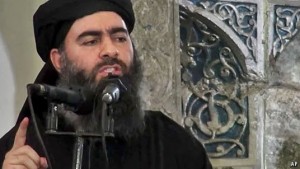The Economist

The ISIS Apocalypse: The History, Strategy, and Doomsday Vision of the Islamic State. By William McCants. St. Martin’s Press; 256 pages; $26.99.
MOST people saw the Arab spring as a failed democratic revolution. Jihadists viewed the various uprisings very differently. For them, the events in 2011-12 and their turbulent aftermath heralded the advent of the Mahdi, the Muslim messiah, and the great battles that would accompany the End of Days, the Islamic equivalent of Armageddon. They sensed a double opportunity. Hastening the apocalypse was a sharp spur to action and recruitment; the Arab spring had helpfully created power vacuums that they could rush to fill.
These two themes—apocalypse and jihad—come together in William McCants’s fascinating study of Islamic State (IS). Half a dozen recent books have recounted how the group emerged in Iraq in 2006, established itself in Syria in 2011 and swept back into Iraq last year. Mr McCants is an Islamic specialist at Brookings Institution, a Washington think-tank, and co-editor of a respected website (jihadica.com). His contribution is to provide something close to an inside account by drawing on leaked or captured e-mails and other messages.
IS and the global movement from which it sprang emerge as a sprawling, quarrelsome, frequently dysfunctional extended family. In its first incarnation, the self-styled state was a disaster. Its figurehead emir, an Iraqi, was a former small-town policeman with no religious qualifications. Its real leader, an Egyptian, was rash and incompetent. By the time they were killed by American and Iraqi forces in 2010, IS was a spent force—and a cause of deep embarrassment to its anxious parent, the al-Qaeda leader, Osama bin Laden. He had vainly urged it to calibrate its violence and win local hearts and minds before rushing to declare a state. He watched helplessly as it failed—and, in doing so, besmirched his brand.
Mr McCants sets out to analyse exactly how IS revived to become the fearsome thing it is today. His explanation is essentially threefold. First, a more credible leadership emerged. The new emir, Abu Bakr al-Baghdadi, claimed descent from the Prophet, had a degree in Koranic studies, and was shrewd and well-connected. Helping him consolidate power was the sinister Hajji Bakr, a bald, white-bearded former colonel in Saddam Hussein’s army, whose first act was a Saddam-like purge of potential rivals.
Second, events in Syria between 2011 and 2014 played into IS’s hands, giving it a powerful new base and precipitating the final break with al-Qaeda. Their divorce— Mr McCants calls it the “biggest split ever in the global jihadist community”—left IS pre-eminent and al-Qaeda gravely weakened.
Third, IS’s proclamation in 2014 of the restoration of the caliphate—in Islamic prophecy, one of the portents of the apocalypse—proved to be a masterstroke. Bin Laden had paid lip-service to the idea but had never taken it very seriously. When IS threw caution to the wind, many Muslims around the world rushed to fight under its black banner. The movement soon had an estimated 20,000 foreign fighters.
Mr McCants adds much unexpected detail. At one point Bin Laden lectures leaders of al-Shabab, his Somali affiliate, on drought and climate change, urging them not to cut down so many trees for charcoal. It seems he also came to regret calling his movement al-Qaeda (which translates as “the Base”) as not being Islamic enough a name. As to the future, Mr McCants wonders if IS’s grotesque brutality will prove its undoing. Not necessarily. Up to a point, he argues, brutality works. Jihadist groups are defeated only when the local balance of forces shifts. IS will eventually crumble, he thinks, but even if it does, others will come forward to emulate it. A grim prospect.







